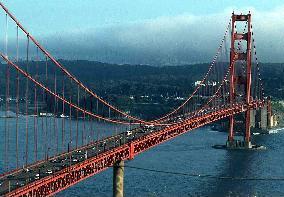|
Explaining TightnessHere is an illustration that might clarify the way tightness in the body works: Let's compare the body to a bridge and the muscles to the cables that hold that bridge up and keep it together:
But if one of the cables becomes weak, or even snaps, all of the other cables- especially the ones directly surrounding the weak or broken one- have to take on an extra load. The extra strain on these cables makes them increasingly tighter, and could eventually make one of them break, which would give the rest even more work to do. And so on... Comparing the bridge to your body: if one muscle is not working properly, the others have much more work to do. So what we experience as muscle tightness in one area is most likely actually a product of weakness in another. If overworked muscles are like the overworked bridge cables, we see that the natural balance of the body is off, and that some others must be either weak or not functioning properly. And, just like the bridge: the more the balance is off, the more compensation that occurs, the worse the situation gets... So what do we do? How should we alleviate the tension of the overworked cables? If we loosen them, the structure gets weaker, and the bridge will eventually fall apart. If we replace or restrengthen the damaged cables, we will succeed in restoring the balance and integrity of the bridge. And likewise with our bodies!! Although stretching, massaging, and relaxing the tight muscles (i.e. loosening the overworked cables) may feel good and provide some temporary relief, these techniques are not meant to actually reinforce the structure of the body. They also do not deal with the initial imbalance that got the body in that place to begin with. In order to return it to its natural, functional balance, we need to locate or let our body locate the weak, inhibited, or damaged muscles and then strengthen them because instability leads to injury.
Note: There is a highly comprehensive system of therapy called Muscle Activation Technique (M.A.T.) that locates and treats neuromuscular inhibitions and weak muscles. In a perfect world, you would have a M.A.T. Therapist and a
Resistance Training Specialist
(who is also Better Than Stretching™ certified) consistently working with you to improve your physical well-being!
|
 When all of the cables are connected, in their places, and working properly, the bridge functions as it should. Just as when the body is in peak performance condition, nothing is too tight or too weak- everything is working together and functioning correctly.
When all of the cables are connected, in their places, and working properly, the bridge functions as it should. Just as when the body is in peak performance condition, nothing is too tight or too weak- everything is working together and functioning correctly. 